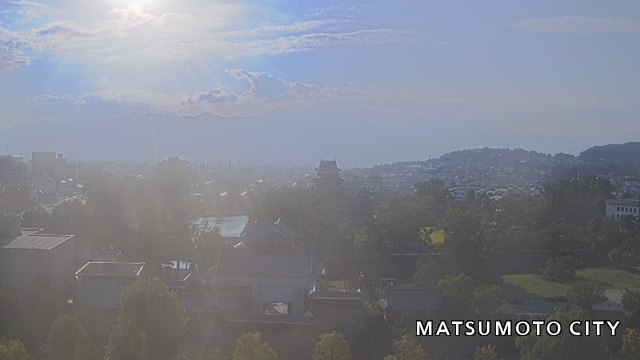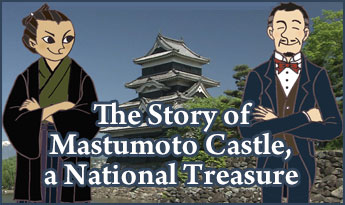National Treasure designation and repair
National Treasure designation
Matsumoto Castle was designated as a historic site in Showa 5 (1930) and as a National Treasure in Showa 11 (1936).
This designation was conducted under the "National Treasures Preservation Law" enacted in Showa 4 (1929), which is sometimes called "Previous National Treasures" separated from the current regulations. As there were many castles designated as the National Treasures including Nagoya Castle designated in Showa 5 (1930), Himeji, Okayama, Hiroshima, Fukuyama, Sendai, Kumamoto, Shuri, Maruoka, Kochi, Uwajishima, Inuyama, Kanazawa, Wakayama, Matsue and Matsuyama before Matsumoto Castle was designated, it can be said Matsumoto Castle was the late designation.
Matsumoto Castle was saved from the calamity of the battles and fire during the Pacific War. It was designated as a National Treasure in Showa 27 (1952) under the "Cultural Properties Protection Law" enacted in Showa 25 (1950). It was designated as a National Treasure following the designation of Himeji Castle. At that time Matsumoto Castle was under repair.
Repair
Expansion and repair at the Edo period
- Expansion It is said that a large expansion of Matsumoto Castle was conducted at the era of Naomasa Matsudaira since it was built at the era of Ishikawa clan. Naomasa constructed the Tatsumitsuke and Tsukimi watchtowers added to the main castle building. As a result, in addition to the connection style that the main castle and Inuiko castle building were connected by Watari tower, the compound style due to Tatsumitsuke and Tsukimi watchtowers was added to the current castle layout, resulting in the connecting-compound style. Moreover, they say that the Tamon tower spreading from the Black gate towards the north was created on the stone wall, which is no longer existing (there are other opinions suggesting that it was built at the age of Ishikawa clan). Two storehouses (Hassen-byo Storehouse) storing rice offered as a tax in the Ninomaru building. A large stable was also built in Rokku outside the castle.
It is said that the Tatsumitsuke tower located in the Ninomaru building was repaired at the era of Mizuno clan, which was extremely damaged when was passed from Horita clan. The Honmaru palace was burnt down in Kyoho 12 (1727) immediately after re-given to Toda clan. Toda clan did not rebuild the Honmaru, and conducted the expansion of Kosanji palace to be used as a new main palace. These were the large expansions of Matsumoto Castle. - Repair It can be assumed that every building was repaired, but we cannot prove it as the lack of records. At the era of Toda clan, after the middle of Edo period, the castle was repaired in Kyoho 18 (1733), Horeki 8 (1758), An'ei 8 (1779), Tenmei 1 (1781), Tenmei 2 (1782), Kyowa 2 (1802), Bunka 14 (1817), Bunsei 9 (1826), Tenpo 3 (1832) and Tenpo 13 (1842). However, the details of the repair are unknown.
- Expansion It is said that a large expansion of Matsumoto Castle was conducted at the era of Naomasa Matsudaira since it was built at the era of Ishikawa clan. Naomasa constructed the Tatsumitsuke and Tsukimi watchtowers added to the main castle building. As a result, in addition to the connection style that the main castle and Inuiko castle building were connected by Watari tower, the compound style due to Tatsumitsuke and Tsukimi watchtowers was added to the current castle layout, resulting in the connecting-compound style. Moreover, they say that the Tamon tower spreading from the Black gate towards the north was created on the stone wall, which is no longer existing (there are other opinions suggesting that it was built at the age of Ishikawa clan). Two storehouses (Hassen-byo Storehouse) storing rice offered as a tax in the Ninomaru building. A large stable was also built in Rokku outside the castle.
Repair at the Meiji Period


In the Meiji Restoration period, Matsumoto Castle was threatened with extinction as castles were not necessary any more. While it avoided to be destroyed, the building including its roof tiles and walls was extremely damaged due to the lack of maintenance. Unari Kobayashi, the headmaster of Matsumoto Junior High School located in the castle premises, was the person who was concerned with this situation. Kobayashi organized the "Matsumoto Castle Preservation Institute" supported by the citizens and raised funds to repair the castle.
The repair construction started from Meiji 36 (1903) to Taisho 2 (1913) through the Russo-Japanese War. Kiju Sasaki was one of the carpenters dealing with the construction of Yamanobe School. Although there is no detailed information regarding the construction, it can be assumed that the part of inner stone steps were changed, braces were added, a trus structure was used with metal fittings, walls were thickly coated and inclination of the building was improved. As a result, the damaged parts were completely fixed while there were some changes on the appearance, such as extra windows. About 80 percent of the costs for this construction was covered by the donations. It means the efforts of citizens led to the completion of this construction.
Repair at the Showa Period

After the Pacific War, Charles F. Gallagher, the art consultant in CIE of GHQ, made an inspection of Matsumoto Castle when he visited Nagano for investigation on the situation regarding cultural property conservation. Consequently, he recommended the Ministry of Education, Science and Culture to start demolition and repair of the castle at the early stage.
Given this situation, Minoru Ooka, the director of the department of construction and restoration in the Tokyo National Museum, and Gaijiro Fujishima, a professor of Tokyo University, started to conduct a survey on the condition of the castle. In addition, the institution called "Matsumoto Castle Landscape Area Preservation Institution" (renamed Matsumoto Castle Conservation Institute) was organized in the local area in Showa 23 (1948), contributing to fundraising and submitting petition letter to the Ministry of Education, Science and Culture. Thus, a groundbreaking ceremony was held on 8th of June Showa 25 (1950) under the direct control of the government.
Showa 25
(1950)6/8 A groundbreaking ceremony August The start of construction 8/15 The general control was transferred from Matsumoto City Museum to Matsumoto Castle Conservation and Construction Office. Showa 27
(1952)6/11 Chona-hazime ceremony (the ceremony praying for the safety of the construction) Showa 28
(1953)10/3 Ridgepole-raising ceremony Showa 30
(1655)10/1 Completion ceremony 10/8 Relocation of 26th Night God 10/15 Transition of work from Matsumoto Castle Conservation and Construction Office to the department of the castle management in Matsumoto City Museum Matsumoto city held the preparation meeting for establishing "National wide Castle Conservation Committee," cooperating with Himeji and Matsue cities on 18th of September Showa 26 (1951). In November, the committee was officially established with attendance of cities having castles. Although The committee used to suspend their activities for a while, it is now called "Japan Castle Management Committee" and conducting conservation and management activities.
The main feature of the repair at the Showa period is that demolition and repair of the entire castle were conducted. In addition, it is also impressive that the foundation of the castle was made of reinforced concrete based on the result of geophysical survey, braces were used for reinforcement based on building strength calculation and the castle building of Edo period was restored by removing the parts added in the Meiji period.
There are some written records regarding this repair construction, including "National Treasure Matsumoto Castle: Demolition and Survey" published by the Matsumoto City Board of Education in Showa 29 (1954), "National Treasure Matsumoto Castle" published by the Matsumoto City Board of Education in Showa 41 (1966) and "National Treasure Matsumoto Castle: Demolition and Restore" by Riki Takeuchi working at a repair construction office.











